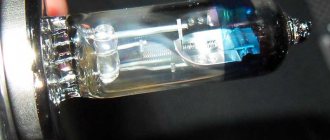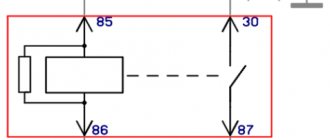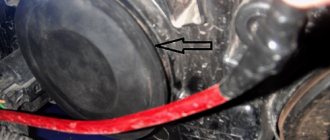You probably read it, but you understood it in your own way... “Less losses before the relay” means less losses before the relay, but not before the headlights. I read about your idea to place both relays and fuses under the hood, and take only the control signal from the interior, this was implemented in 05/07 with their mounting block. So, installing a mounting block and under-hood wiring 2107 under the hood may be too radical a measure. I also looked at diagram 07, so there is an “ignition relay”. In our diagram it could be that contact “15” of the ignition switch is the control contact on the relay (86 relay contact), contact “30” of the relay is a branch of the same lock contact, ground (85 relay contact) and “87” relay contact goes to 10th pre, that is, the excitation winding of the generator. Does such a relay make sense?
[quote=»si100884tnk»]Does it make sense to install a separate relay for side lighting or is it enough just for the unit? and gave. light?
How to check the voltage at different points in the car network?
It is best to use the services of a car electrician for this purpose. A specialist, using special instruments, can quickly find out the point where the trouble arose. The voltage at different points of the on-board network may differ, as consumers reduce it. One of the universal measurement methods is to check the voltage with a tester at the battery terminals. There are several recommendations on this matter:
- if the measured voltage is less than 13.5V, we can talk about insufficient network performance; the problem often lies in the generator or connecting parts;
- it is worth measuring the voltage in various modes, such as idle speed, increased speed, ignition state, as well as the inclusion of all present consumers;
- An important point is the quality of the device used, since Chinese compact testers show fairly approximate figures that cannot be taken as a basis for repairs;
- if the measured contacts are oxidized, then the indicators may be different; it is worth cleaning the measurement points a little to obtain normal results in the end;
- If the voltage on the battery is normal, you should go further, measuring the indicators on the headlight bulbs, on the cigarette lighter and other open consumers accessible without disassembly.
However, even if you find the part that caused the problem, it will be extremely difficult to fix the problem without special knowledge and skills. But it can save you time and money at the service station. Very modern cars, when the voltage drops in the network, report an error and strongly recommend that the owner contact service. Some models even stop moving and require immediate intervention from a technician. So even minimal problems in automotive electrical systems should be monitored very carefully.
Voltage drop and uneven operation - logbook of the 1988 Lada 2108 on DRIVE2
With the arrival of cold weather, I started having problems with the generator. The problem is that when the low/high beams and the heater were turned on at idle, the voltage began to drop to 11.5 - 11.9V. As a result, there was a slight unevenness in the operation of the engine, vibration increased slightly, the battery was not properly charged, the instrument lighting and headlights dimmed. Regarding this, one person I knew said that initially the voltage regulator was installed on the generators at 12V, then they started installing it at 13V , but now they set it to 14V.
After installing the regulator at 14V, the problems were somewhat resolved. When you turn on the light and stove, the voltage drops to 12.5 - 12.7V, but a slight unevenness of operation and vibration still appears (less than what was initially). Maybe someone can tell me what, maybe this is not connected with the regulator? By the way, there is also a problem with the idle needle on the carburetor. There is a homemade needle with a slightly larger diameter, I suspect, through a thread that was once torn off. If you believe the Chinese electronic tachometer, then the revs at idle fluctuate a little from 750 to 900. By ear, without a heater or light, the car runs smoothly. When you turn on the stove and lights, you immediately hear interruptions and vibration.
www.drive2.ru
Voltage drop when turning on the fan. — GAZ Volga community on DRIVE2
The problem is this: When you start the engine when it’s cold, either without consumers or with the low beams, PTF, heating, etc. on, the voltage across the on-board and dash stays at 14.5V.
When the engine is warm at idle, with all consumers, the instrument and on-board display also show 13.9-14.0 V. As soon as the coolant temperature reaches 91 degrees and the fan turns on, the voltage drops to 12.0 - 12.3 V, if music is also playing loudly at that moment - the voltage drops below 11.4 V. I thought that the wire that goes from the generator to the engine compartment fuse block was to blame - I got around to replacing it with a wire of a thicker cross-section - but the result when turning on the fan remained the same - a drop to 12.0 V. After the fan completed the cycle, the voltage returns to normal again. If you turn up the gas pedal while the fan is running, the voltage also returns to normal.
Engine 406; BOSCH fan; generator 78A (if I'm not mistaken); The generator is equipped with a remote 3-level regulator ENERGOMASH (the switch is in the MAX position); Mutlu battery (about 2-3 years old for sure, the viewing window is green); A little over a year ago, the diode bridge on the generator was replaced (since the charge was completely lost). The engine compartment fuse box itself is new, the contacts are clean and free of oxides. The wire from the generator to the block has a cross-section of 25mm.sq. There is also music installed with two amplifiers, a subwoofer and a storage device.
The question is: Has anyone had something similar? What could be the problem: in the generator itself, or maybe it’s time to change the battery or something else...
Voltage on the old wire.
Voltage on the new wire on a warm engine with the following switched on: Middle; PTF; music; ZPTF. No fan.
Voltage drop when turning on the fan with: Middle; music; PTF.
The wire itself that I installed to replace the old one.
The signal lamp is blinking
Blinking of the battery indicator, as a rule, indicates problems in the brush assembly, as well as the occurrence of a short circuit in the “W” and “-” terminals of the voltage regulator. The brushes, in turn, can “freeze”, not reaching the rotor slip rings at low and medium speeds. You have already read how to fix them in our instructions. However, the reason why charging on the Niva 2121, 2131, 21214 and 4×4 Urban disappeared is not always the above-mentioned components under the hood. In particular, the culprit of weak charging or its complete absence is an unmaintained battery with an insufficient volume of electrolyte or closed banks, loose and oxidized terminals, broken and melted wires. Additional difficulties arise when dirt, dust, traces of fuel and lubricants, etc. accumulate on suspended equipment.
Electrical faults
Current leakage may be the reason why the speed fluctuates when the headlights are turned on. Here you cannot do without a qualified diagnostic technique. Drawdown may occur during the installation of non-standard alarms, radios, cameras, navigators, and other equipment. In 90% of cases, difficulties are caused precisely by independent modernization of the vehicle. The worst thing in this regard is a deep discharge of the battery. With independent intervention, the battery may one day simply stop working, then the engine will completely refuse to perform tasks. Up to 75 mA, the electrical leakage rate is considered normal. How to identify such a nuisance before visiting a professional service?
- Buy a simple multimeter. It will cost 300 rubles, but the benefits will be tangible.
- The hood opens and the negative battery terminal is unscrewed. It needs to be removed.
- The tester is put into electric current measurement mode. Measurements are carried out using the probes of the device. To do this, they must be placed between the terminal and the battery contact.
It is reasonable to ask the professionals – what to do?
We identify generator malfunctions
The above-mentioned checks make it possible to quickly identify malfunctions of elements of the on-board power supply network, short circuits and other problems. But if the problem is not in the system itself, diagnostics of the generator will be required. In the vast majority of cases, it reveals one of the following problems:
- generator winding break. It is detected using a voltmeter to measure the voltage at the output. To eliminate a break in the outer winding, it is enough to solder, but an internal break requires a complete replacement of the coil;
- short circuit between turns, detected using an ohmmeter. The generator often cannot charge the battery due to increased resistance of the coils;
- insufficient contact between the rotor rings and brushes. The main causes of this problem are contamination of parts or weakening of springs. In the first case, you can simply clean the surfaces of the brushes or rings, but in the second, you will need to replace worn components;
- a short circuit to the housing, which can be eliminated either by high-quality insulation of the generator or by replacing the failed winding;
- short circuit to the stator housing or positive terminal. “Cureable” by installing new parts;
- stretching of the generator belt, its severe abrasion or wear. In this case, the equipment not only does not work correctly, but also gets very hot, so you can quickly detect the problem;
- short circuit in the phase winding.
Another fairly common problem is the failure of the generator voltage regulator. This device is installed in order to normalize the current generated by the unit and supplied to the on-board network, maintaining it within strictly defined limits. Operating a car with a broken regulator is strictly prohibited, as there is a very high risk of failure of all electrical equipment
Therefore, it is very important to detect the problem in a timely manner and eliminate it.
Why does the VAZ-2110 generator not charge the battery?
The standard equipment of the VAZ-2110 car includes a battery with a capacity of 55 Ah. It holds a charge quite well and may not require refilling for many months. The thing is that all voltage losses are compensated by the operation of the generator. If the latter fails for some reason, it is very important to promptly detect the malfunction and eliminate it. Otherwise, the generator does not charge the VAZ-2110 battery and poses a serious threat to the entire power supply system of the vehicle.
How to determine that the network voltage is insufficient?
The easiest way is to get information from the on-board computer. Most often, even inexpensive computers have a function for measuring this parameter. Most devices have a built-in alarm function for problems with the on-board electrical network. For example, if the voltage drops below 12V, a certain signal is triggered and a message is displayed with various content options. The following problems may also occur during the process:
- a decrease in the activity of the instrument panel lighting, as well as various light blocks, including dimensions, brake lights, turn signals, low and high beams, they dim;
- at idle speed the car begins to choke and even stalls, this is due to a lack of voltage, a fatal drop in the entire system occurs, fuel is not supplied;
- the radio tape recorder fails, it can simply turn off and then turn on itself if its connection is configured correctly, this happens when there is a power surge in the lower zones;
- when you turn on the interior blower fan or air conditioner, there is a noticeable effect on the engine, the speed drops, there is an effect on the quality of lighting by the optics;
- Voltage fluctuations are noticeable during warm-up and during normal idling of the engine, this can be seen from the flickering of lights and uneven engine operation, floating speed.
These are the kind of troubles that can make you think about problems in the electrical network. These are only visible problems, but in reality this trouble has a much wider range of influence. The reliability of the fuel pump, the normal functioning of the on-board computer and the absence of errors with it depend on the quality of the voltage in the network. Let's figure out exactly which components can lead to such troubles in your car.
Advertisements on NN.RU - Auto
The broken-type towing platform produced in our company has a highly reliable design, which is confirmed by many years of use.
A specialized company for converting trucks into tow trucks invites you to install a tow truck platform on.
Wide selection of hydraulic pumps and hydraulic motors of all series. Axial piston hydraulic motor. Splined shaft, reverse rotation. Analogs - (many. Price: 1,000 rub.
Lengthen Gas 331043, 331063 Valdai-farmer for installation of a body 5.1/6.5 m. The chassis is lengthened by increasing the wheel size.
Adblock detector
Reduced voltage when driving
#1 AntonSt
Users 983 messages Registration 19-May 14
- From: Kyiv
- Car: VAZ 21011
Observed when the headlights, low beam, heater, and wipers are on. The speedometer light flickers. The on-board computer shows a voltage of 11.5 V. If you turn everything off -14.3V.
Generator problem? How to solve it?
Added after 34 seconds Just saw this today.
#2 A.S. 2101
Users 329 posts Registration 04-Jun 06
- From: VAZ 2101
- Car: 1974
#3 nalsur4
Users 593 messages Registration 03-Oct 12
#4 DVA
Users 871 posts Registration 14-March 09
- From: Gostomel-Kyiv
- Car: VAZ-21053->Lanos
#5 AntonSt
Users 983 messages Registration 19-May 14
- From: Kyiv
- Car: VAZ 21011
#6 foxxx
Users 148 posts Registration 25-Dec 11
- From: Lozovaya
- Car: VAZ 2106
#7 djurka
Users 3,692 posts Registration 18-September 09
#8 Professor
Users 104 posts Registration 22-Jan 15
So as not to create a new topic. In the evening, with the light on, when you press the stop button, the voltage drops (today I’ll install a voltmeter and measure how much), the backlight of the radio and the backlight of the devices go out. What the hell?
#9 djurka
Users 3,692 posts Registration 18-September 09
#10 sobur2000
Users 102 posts Registration 04-Jun 12
#11 nalsur4
Users 593 messages Registration 03-Oct 12
#12 AlexandrB
Users 2,986 messages Registration 09-December 05
#13 AntonSt
Users 983 messages Registration 19-May 14
- From: Kyiv
- Car: VAZ 21011
Belt tension is normal. European standard fuses. A copper wire is installed to ground. The problem is subtle, but remains. I can hear it from the floating speed of the stove.
I talked about this topic with a colleague. He says you need to install a generator from 2108 with a current of 90A. In a penny - at 45A. But the equipment is standard, designed for this generator.
#14 Creative4eg
Administrators
13,833 messages Registration 24-July 12
- From: Kyiv
- Car: VAZ 21063i
What does the standard equipment for a 90A generator have to do with it?
Added after 2 minutes I have it set to 80A, everything works. Charging is stable, nothing sags or blinks anywhere. it's the other way around +
Your time is limited! So don't waste it on someone else's life! (Steve Jobs) “a corrupt gang that replicates stickers for traitors to the classics” (c) Zir
#15 AntonSt
Users 983 messages Registration 19-May 14
- From: Kyiv
- Car: VAZ 21011
Argues that there is insufficient current for the system. Why is the battery not charging? In the end, where to dig?
Added after 51 seconds Generator 2101, if I'm not mistaken, produces an output current of 45A.
Added after 1 minute I meant standard for a penny, with a current of 45A. In theory, everything should work without flickering on a cheap generator.
#16 Creative4eg
Administrators
13,833 messages Registration 24-July 12
- From: Kyiv
- Car: VAZ 21063i
What kind of battery do you have? stock, 45-50A. Are the light bulbs also stock? cassette player? registrar (if any)?
Added after 24 seconds
this is the maximum current.
Added after 1 minute and to be precise, it is only 42A
Your time is limited! So don't waste it on someone else's life! (Steve Jobs) “a corrupt gang that replicates stickers for traitors to the classics” (c) Zir
#17 AntonSt
Users 983 messages Registration 19-May 14
- From: Kyiv
- Car: VAZ 21011
ACC Centra Futura 60Ah 640 A - starting current.
The light bulbs are stock, there is no radio, there is a recorder, there is an on-board computer BK-06.
I turn on the dimensions, low beam, instrument lighting, and heater.
Added after 36 minutes Could there be a problem with the brushes?
#18 Creative4eg
Administrators
13,833 messages Registration 24-July 12
- From: Kyiv
- Car: VAZ 21063i
Your time is limited! So don't waste it on someone else's life! (Steve Jobs) “a corrupt gang that replicates stickers for traitors to the classics” (c) Zir
#19 AntonSt
Users 983 messages Registration 19-May 14
- From: Kyiv
- Car: VAZ 21011
#20 Emissions
Only connecting rods go into battle
Moderators 16,362 messages Registration 26-November 12
- From: Kyiv
- Auto: 21061, 21083
- Page 1 of 4
- 1
- 2
- 3
- Further
The topic is old, but I’ll try to revive it with my concerns.
I have a 2-liter J20A engine, I bought a new 60Ah battery, drove it for 2 weeks, and decided to monitor the voltage. After a week's parking in the garage, the voltage is 12.7V, the electrolyte density corresponds to 80% of the battery charge. I started it, at warm-up speed it shows 16V, with consumers turned on 15.5V. At the end of the day I measured it again, at idle it shows 15V, with consumers 14.5V. Is this voltage higher than normal? Is the battery overcharging, what will happen to it? They point to the voltage regulator, if it is at fault, approximately how much it might cost to replace it, whether it is hemorrhoidal.
Your voltage is raised by 0.5V. And what changes with temperature is the norm. The generator has a dependence of the output voltage on temperature. Until the gene warms up, the voltage is slightly increased. The Kama Sutra has a graph of this dependence.
was TD01W AT, 1996 was QASHQAI, 2010
Patriot, 2014, green like UAZ
Have you checked/changed the brushes? The point is in them and the cleanliness of the contacts on the anchor on which they slide.
I changed the tablet in the gene in the summer of this year, it cost me work, i.e. soldering and testing costs 1200 rubles.
Overcharging causes the electrolyte to boil off and 16V is already dangerous for the computer. Because of the regulator, the voltage seems to be higher - 17-20V. If it is constantly 1V higher than the norm, maybe the regulator, or maybe there is something wrong with the wiring, connector, grounds and brushes, the regulator thinks that there is low voltage on the battery and adds it.
You can buy a regulator if there is a problem with it, or you can make a remote tablet from Audi-Opels for 300 rubles, the result is about the same, but you need to delve into the circuits and wires, this one has been working for me for two years.
The faulty regulator is unsoldered, and the brushes and the wire from the accessory are brought out. diodes and lamp wire. Further, any options with an external regulator are possible. I tried it with extras. diodes and from the battery, charging from the battery is better - strictly 14.5V after 2000 rpm. But if you regulate from the battery, and not from the add-on. diodes must be connected through the ignition relay, otherwise there will be a small constant discharge through the regulator in parking lots.
Last edited by gorst; 12/27/2009 at 01:57.
By the way, yes, it is very useful before changing the generator, battery, then the engine, then the car itself.
I had this happen (all the automatic transmission floats did not work correctly, the overdrive did not turn on, when the neighbor was turned on, the temperature sharply increased, it went off scale)
It turned out to be a minus on the body soured. Clean the sandpaper, press the bolt harder and everything is gone, or returns to normal.
Guys, I have the same problem as Dronna. The trick in this topic is as explained to me by the electrician D. Vasya, who also has an Escuda! He says that there are different genes on the G16A, on the short ones they are a little less than 5 doors. And what happens is that in some miraculous way, the winding of the genes burned out or simply burned out! Without load, that is, during the day, it charges normally. With the headlights on low beam, it charges for about 10 minutes, then it warms up, charges but less, and when you turn on the wipers, fog lights, heated glass, high beam. It heats up even more and my face gives 5 V charging. And when it’s cold, you can’t hear it, and when you turn off the engine it’s also normal! And when it heats up, it makes sounds “Clack clack clack,” and somewhere after 2000 rpm, and when it gets hot and you turn off the engine, it makes a sound as if a 220 wire is breaking through. I personally heard this with the hood open, so take a look at the winding! You can also hang up the device and turn on the consumers one by one, otherwise one of them may be the cause
Last edited by Fiasko; 12/27/2009 at 06:39.
We are looking for problems - the main culprits of the voltage drop
The problem is that your car may have a number of individual problems that lead to a drop in voltage. Therefore, only a specialist can tell the reason one hundred percent after examining the entire electrical circuit and performing high-quality diagnostics. Without inspecting the car, you can only guess the real problems and speak in general terms. However, there is a certain set of blocks and equipment that is responsible for voltage. This is what you should check first:
- battery - if this device is completely discharged, the computer tries to replenish its resources and sends the lion's share of the generated energy to charge and restore it;
- generator - a broken diode bridge can cause a significant drop in network performance, and this will cause problems with the battery in the future;
- voltage regulator (tablet) - installed on the generator and distributes voltage flows from this device; if it breaks, it can put an excessive load on the engine;
- too powerful equipment - for example, you could install a sound amplifier and subwoofer that the on-board electrical system of your car simply did not support;
- a failed consumer of electrical energy - this could be a burnt-out fan, a broken fuel pump, failed headlights, an air conditioner and other components.
Of course, this is not a complete list of possible causes of problems.
It is worth remembering the importance of proper operation of the electrical network. In case of malfunctions and constantly low voltage, a variety of troubles are possible, including burning of important parts and simply low reliability of the vehicle as a whole.
So it’s not worth driving with such a problem for a long time. You should immediately send the car to a service station or perform independent diagnostics.
Why does the voltage drop when the headlights are turned on?
Voltage drop when turning on low beam? Here I will offer you two reasons for this misunderstanding. One is related to a malfunction of the generator, the second is related to the installation of high-power lighting fixtures.
Consequences of installing a high-power lamp on a car
So, the first reason why the voltage in the network drops is the installation of a lamp of such power that is not prescribed by the manufacturer. Why do this? Yes, the reason is banal, car enthusiasts want to get a more powerful lighting effect, without thinking that a significant voltage drop in the car’s electrical network is not the only negative consequence that a driver can experience. Moreover, problems arise not only for the owner of highly efficient lighting, but also for other road users.
Overheat
The second problem with a high-power light bulb is its overheating. In principle, we can safely assume that all the power consumed by a “cool” lamp will turn into heat. Moreover, if you think that this only applies to incandescent lamps, you are very mistaken. Halogen and LED lamps are also among the “heaters”, although, of course, to a lesser extent. The situation is further aggravated by the fact that modern headlights are completely sealed, so the heat often simply has nowhere to go!
Even when standard light bulbs are installed, their temperature during operation reaches such an extent that the plastic elements of the headlights can barely withstand it. And if you install even more powerful equipment, the headlight will inevitably fail over time.
Dazzle of oncoming vehicles
The power of lamps for a particular car is not taken from the ceiling, but is selected in such a way that they do not create discomfort for oncoming drivers. With all this, the manufacturer takes into account circumstances such as inaccurate distribution of light in the headlight under real operating conditions. If you install a stronger lamp, the situation ahead will be illuminated much better, but at the same time, the visual damage to oncoming motorists will become prohibitively high.
Do not rush to install a more powerful product, because a weak light bulb may not provide the proper degree of illumination, not because it is weak, but because it is dirty both outside and inside, and also because it is misaligned. All these troubles lead to disruption of light distribution and a drop in illumination in the light area, however, in the shadows, on the contrary, efficiency increases. If you try to neutralize this circumstance with a more powerful light bulb, then in the end the drivers of oncoming cars will be clearly unhappy with this innovation of yours.
Before replacing an old lamp with a new one, make sure that your lighting fixtures are in good condition. Replace the light bulb with a similar one provided by the car manufacturer!
Problems with the generator
Let's move on to the second reason, more complex! Moreover, when you turn on the headlights, not only will the voltage drop, but they themselves will emit a dim glow.
Car diagnostics to identify problems with battery charging
First, we need to check the correct operation of the battery charge indicator located on the dashboard. It is quite possible that it is simply showing incorrect data, confusing you, and no serious repairs will be required.
The next important step is to check the functionality of the fuse. It is better to immediately replace it with a known-good device and try to start the engine. If the charge indicator goes off immediately, the problem has been detected and successfully resolved.
Battery still won't charge? Let's try to detect a current leak, if any. For this purpose, we check the car when it is cold, when all its systems are completely turned off. A small voltage release in such a situation is considered normal, since in almost any machine a weak contact can be detected in some parts of the circuit and a local short circuit can be identified. If the leak is so large that the generator is not able to charge the battery, the alarm should be sounded.
If there is no strong current output, we carry out exactly the same test, but with the connection of the equipment installed during the tuning process. In this case, this will be the cause of the leak. The easiest way to solve the problem is to remove all third-party devices.
Reason #9. Insufficient cross-section of wires in the battery charging circuit
Occurs after serious and inept repair of car wiring. Insufficient cross-section of wires in the generator-battery circuit is a guarantee of low voltage on the on-board network. In addition, even “native” power wires can have a small cross-section. Over time, the veins gradually break at the bends and at the attachment points, as a result of which the resistance of the chain section increases. Repairing both the first and the second is elementary.
vote
Article rating
Why do the revs drop when the headlights are turned on?
On most cars, normal operation of the generator is ensured at a value of about 1000 crankshaft revolutions per minute. Turning on the headlights leads to an increase in the current consumption of the on-board network, to which the generator (or rather, the voltage regulator) must react. Its response speed is quite high, but if, at the moment the external lighting was turned on, the engine was idling, and for a relatively short time, the battery energy spent on starting the power unit does not have time to be restored in a relatively short period of operation of the generator. It turns out that the battery is still in a discharged state, and when the additional consumer is turned on, the generator begins to brake the crankshaft, creating resistance to the engine.
But this is only possible with a very discharged battery, so the first thing you need to do is run a battery diagnostic. Note that with a discharged battery, you will probably experience difficulty starting the engine, and this is a more compelling reason to take care of its prevention.
But the reason for the drop in speed may also be a banal overload. The fact is that automakers install generators for each model that are designed for a certain load (with a margin, of course). If you stuff the car with additional consumers (install a powerful audio system, connect external optics or a considerable number of electronic gadgets), the load on the generator increases, and it is no longer able to cope with their power supply, which is why the engine power drops. Here the recipe is obvious - reduce the total power of electricity consumers to an acceptable value, and if this is undesirable, install a more powerful generator.
However, if the engine speed drops when the lights are turned on, the reason may lie in both current leaks in the electrical circuit and problems with the generator itself (wear of slip rings, bearings, brushes). Please note that it is not recommended to solve electrical problems yourself; an experienced auto electrician is required.
It is also worth checking the tension of the drive belt; perhaps the causes of unstable engine operation are wear on the piston rings. In a car with a carburetor, a possible cause may be a violation of its adjustments (lean mixture).
Finally, on injection engines, if the idle speed drops, the responsibility can be placed on the IAC, and if this happens while driving, on the TPS.
The main reasons why the generator does not charge the battery
To identify problems, it is necessary to diagnose both the entire on-board network, which may draw too much energy, and the generator itself. If you have tuned your car, equipping it with additional electrical equipment, you will need to check its energy consumption level and serviceability.
Very often, to compensate for the current consumption of third-party devices, car enthusiasts install high-capacity batteries. However, the generator power remains at the same level, so this measure has no effect.
Why does the charge drop when the light is turned on?
#1 Ivan522
- Participant
- 9 messages
- Gender: Man
- City: Kemerovo
- Interests: Auto
- Car:VAZ 2108
Post edited by Ivan522: 08 September 2012 - 18:23
Master 418 posts
Master 508 posts
Forum Partner 1,569 posts
#5 Serga
Master 2 113 messages
- Gender: Man
- City: Kazan
- Interests: Car enthusiast
- Car:Priora Station Wagon
Post edited by Serga: 08 September 2012 - 18:41
Member 24 posts
Master 418 posts
#8 Ivan522
Member 9 posts
- Gender: Man
- City: Kemerovo
- Interests: Auto
- Car:VAZ 2108
Yes, the needle goes down on the instruments, but also on the multimeter. I took measurements at the terminals, with the engine running without load 13.7-13.6, when I turn on the consumers the light + heater drops to 12.8 = 12.9
The old Akum sat down quickly, I don’t know about the new one yet, the scale does not fall into the red zone, but goes beyond the average mark closer to it
Regarding the measurements of the plus on the engine plus and on the body, do you mean transferring the mass from the engine to the body?
Master 399 posts
#10 POTAP 123
Moderator 1,773 posts
- Gender: Man
- City: Russia. Mr. Sulin
- Car:HYUNDAI ACCENT
https://Worlds-Car.com/motor-chip.ru
Carthogen must be destroyed. Carthago delenda est, Carthaginem delendam esse
#11 igor4230
Master 418 posts
Attached files
blog-vaz-generator-2108-ft8-norm.JPG42.86K 48 Number of downloads:
Post edited by igor4230: 09 September 2012 - 08:15
#12 Dmitriuk
Master 765 messages
- Gender: Man
- City: Kremenchug, Ukraine
- Interests: Diagnostics (professional), electrical equipment repair
- Car: Daewoo Lanos 1.5L
The old Akum sat down quickly, I don’t know about the new one yet, the scale does not fall into the red zone, but goes beyond the average mark closer to it
Regarding the measurements of the plus on the engine plus and on the body, do you mean transferring the mass from the engine to the body?
Well, firstly, 13.7 - 13.6 without load is ALREADY LITTLE. Must be at least 13.8. Ideally 14.0. On normal foreign cars it’s generally from 14.2 to 14.5. And it doesn’t matter whether it’s with or without a load. What could it be? The devil knows, Comrade Major, you know better))) But seriously, check the voltage output directly from the generator - with one probe on the positive terminal, the other on the generator housing. If everything is ok there, look further. There may be a problem with the wiring. Try disconnecting the D+ terminal from the generator with the engine running. If something changes, it is possible that the wire is shortened to ground somewhere. Check the stator winding for breakdown - it is possible that a dog is buried there somewhere. Well, etc., according to the list. By the way, the charging relay may also be defective or incorrectly connected.
Post edited by Dmitriuk: 09 September 2012 - 08:17
Master 418 posts
how is it not like that. all this diagram is how to connect a classic RR excitation goes along +. in a standard 2108 relay regulator, excitation goes along -. this scheme is for such a RR. for 2108 generator.
I can’t understand why the voltage sags
#1 [email protected]
- Users
- 76 messages
- Gender: Male
- City: Baranovichi
Hi all. The question is, on the battery without load 14.4V, with the furnace at maximum, rear heating 14.1-14.2. As soon as I turn on the radio, it immediately drops to minus 0.2-0.3V, at a volume of 21 out of 50 it drops to 13.8, without other consumers, the voltage with them is approximately the same. Gena Bosch 90A, new regulator. P.S. There is a subwoofer, BUT it is turned up almost to the minimum and when it is turned off, the radio still eats up to 0.3V, isn’t it crazy? P.S.2 plus radios directly from the battery, control plus with the ignition on, 2.5mm wires on the mag, on the subwoofer the thickness is almost a finger.
- Top
#2 Lobun
- Gender: Male
- City: St. Petersburg.
Low voltage when starting the engine: how to find the cause
Let's start with the fact that the battery is not always the culprit of all troubles, although quite often reduced voltage occurs as a result of problems with the battery. In any case, before you start diagnosing a car regarding electrical parts, you must have a special auto tester (multimeter).
It is important that the device accurately measures certain parameters. As a rule, the functionality of the device should allow you to measure voltage, resistance, current
At the same time, when troubleshooting voltage-related problems, you also need to take into account the crankshaft speed.
Checking the car battery
So, when diagnosing, you need to start by checking the battery, as well as the car generator. The condition of the battery is assessed by connecting the tester to the battery terminals. Normally, the voltage on the battery, taking into account the absence of load (all consumers are turned off), should be at least 12.6 V. A decrease in this indicator means that there is a partial undercharge or problems have arisen with the battery itself (sulfation of the plates, boiling off of the electrolyte, etc.).
You can also measure the voltage with a voltmeter, turning on the side lights and high beam headlights for the load. Typically, the discharge current under such a load (taking into account the installed halogen incandescent lamps) is about 5–6 A, and the voltage is about 11.5 V. If this is the case, then the battery is working and the problem needs to be looked for further.
Quick starter diagnostics
If we talk about the voltage directly at the moment of starting (when the starter turns), the voltage at the battery terminals should not fall below 9.5 V. In cases where this happens on a working and charged battery, it can be argued that a starter malfunction has occurred. In other words, the starter requires too much electrical energy when operating, which should not normally be the case.
Let us add that to measure the current you need an ammeter, which is connected to the gap. At the same time, it is highly not recommended to break the circuit in a car; also, not all ammeters are able to work correctly and record high readings that occur when the internal combustion engine is started.
For this reason, it is better to have a special motor tester for such tasks. The main advantage of the device is that the measurement accuracy is quite high, and there is no need to connect the tester to the break, since the device has separate sensors. These sensors are overhead and work even through wire insulation. These elements are capable of effectively recording changes in magnetic field strength when a current of one or another magnitude passes through the wires in the circuit.
Assessing the performance of a car generator
In cases where the battery has been previously checked and charged from the charger, and everything is in order with the starter, but the problem continues to appear, the generator needs diagnostics. The fact is that the generator recharges the battery after the engine starts. If the necessary recharging does not occur, then the battery quickly runs out, rapidly losing charge after just a couple of starts.
Then you can raise the engine speed, after which the charging voltage is also measured. For example, when the engine speed increases to 2 thousand rpm. The normal charge voltage ranges from almost 14 to 14.5 V. Next, the operation of the generator should be assessed under load. To do this, you will need to turn on the headlights again.
The voltage is normal after turning on the lights and dimensions should not be lower than 13.8. If the indicator drops to 13 or lower, then you need to start checking with the generator drive belt. If the alternator belt is loose or slipping, then the cause is obvious. If the belt is well tensioned, problems have arisen in the generator itself or its relay regulator.
As a rule, the relay regulator is one of the most common problematic elements on different cars. You can check the relay regulator in the following way:
- it is necessary to measure the voltage on a running engine;
- after the indicator reaches 14.5 V, the charge should stop;
- if the voltage continues to increase, the relay regulator requires replacement (adjustment is allowed on some cars);
Let us also add that the charging current after the engine has been started ranges from 6 to 10A. Subsequently, when the internal combustion engine is running, the charge normally drops to 0 (provided that additional electricity consumers are turned off).
When starting the engine, the voltage drops: causes and diagnostics
Voltage drop when starting the engine is a fairly common problem, regardless of the type of power unit, as well as the make, model or class of the car.
The voltage drop often manifests itself in such a way that at the moment the starter begins to rotate, the headlights sharply dim or go out, the dashboard lights lose their brightness, the radio turns off and restarts, etc. A voltage drop can occur both when trying to start a cold internal combustion engine, and when starting an already warmed-up unit. As for the start itself, in some cases the starter actively turns for the first couple of seconds, then a certain “stutter” occurs. At this moment, the voltage drops, while the crankshaft continues to turn, but with great difficulty, but a serviceable engine usually starts.
There can be several reasons for such a malfunction, both obvious and easily removable, and hidden. In this article we will talk about why the voltage drops when starting the engine, as well as how to detect and fix the problem.











